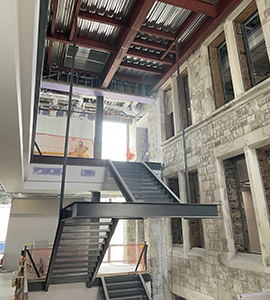Loyola approves Green Building Policy to advance sustainability efforts on campus

All new buildings and major renovation projects at Loyola University Maryland will be built in accord with the University’s new Green Building Policy. The policy was approved by Loyola Conference, the University’s shared-governance body, on April 20, 2021. The University will look to the U.S. Green Building Council's Leadership in Energy and Environmental Design (LEED) framework with the goal of achieving a LEED Gold rating for each new building or major renovation project.
“The Green Building Policy is a bold step forward for the University and will produce lasting positive impacts for our campus and the local environment,” said Taylor Casalena, sustainability coordinator at Loyola.
The vision at the U.S. Green Building Council (USGBC) is that buildings and communities will regenerate and sustain the health and vitality of all life within a generation. The USGBC mission is to transform the way buildings and communities are designed, built and operated, enabling an environmentally and socially responsible, healthy, and prosperous environment that improves the quality of life.
LEED, or Leadership in Energy and Environmental Design, is the most widely used green building rating system in the world. Available for virtually all building, community, and home project types, LEED provides a framework to create healthy, highly efficient, and cost-saving green buildings. LEED certification is a globally recognized symbol of sustainability achievement.
The purpose of this policy at Loyola is to align the design and construction of new buildings and major renovation projects with the University’s existing commitments to support sustainability and action on global climate change. Loyola is committed to sustainable design and construction that meets or exceeds USGBC’s LEED Gold rating, or equivalent.
Green building design and construction at the LEED Gold level was included as a strategy in Loyola’s 2015 Climate Action Plan and considered again in the Mission Priority Examen self-study four years later.
This is another step toward reducing the University’s carbon emissions to net-zero as soon as possible. A commitment to green building and renovation will reduce carbon emissions generated by university owned properties and facilitate the success of the university’s sustainability goals.
The proposal for the Green Building Policy was brought forth by the Sustainability Committee at Loyola. Members of the Sustainability Committee who contributed to writing this policy include Casalena, Elizabeth Dahl, Ph.D., associate professor of chemistry, Edwin Morgan, director of facilities, and James Snow, Ph.D., faculty co-director of Messina. Helen Schneider, associate vice president for facilities and risk management, and Meredith Sullivan, director of project management design and construction, assisted with this initiative.
“The adoption and implementation of the Green Building Policy for Loyola demonstrates our ongoing commitment to environmentally responsible building practices,” said Sullivan. “It is important for all of us to be good stewards of the environment and lead by example for our community.”
The Miguel B. Fernandez Family Center for Innovation and Collaborative Learning will be the first LEED-rated green building on the Evergreen Campus. When the Fernandez Center opens in Fall 2021, it will be equipped with advanced storm water management infrastructure, highly efficient heating, cooling and lighting systems, and sustainable fixtures and appliances. It is expected to cost 40% less to operate compared to a conventional design, reducing pressure on the University’s utilities budget.